
Since most bass rigs tend to be pretty simple affairs, it makes sense that you’d want a simple amp option, too. The options on this list are on par with our best small combo guitar amps post. They’re primarily aimed at practice and some recording work, but aren’t as likely to be able to cut it at a show. That said, I’ve gigged with a 40-watt bass combo with an assist from the house PA, so you may have similar luck. We’ve set the budget here at $300 and a minimum of 40 watts, if possible.
There are many factors at work here, but if you plan to do anything but practice with this amp, go for as many watts as you can afford. There are no hard-and-fast rules; if you’re cutting through the mix with fewer watts, you’re in good shape. A good place to start is three to four times the wattage of your guitarist’s amp, preferably with a larger speaker.
Choose the best bass combo amp from our list for use at practice, in the studio, and beyond.
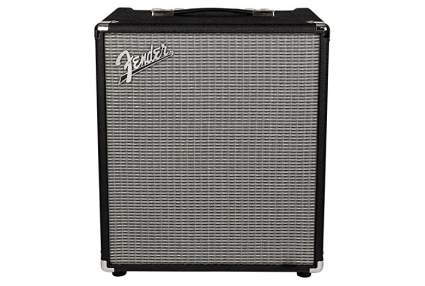
|
Amazon Customer Reviews
|
Price: $329.99 Shop at Amazon | Shop now Read our review |

|
Amazon Customer Reviews
|
Price: $329.00 Shop at Amazon | Shop now Read our review |
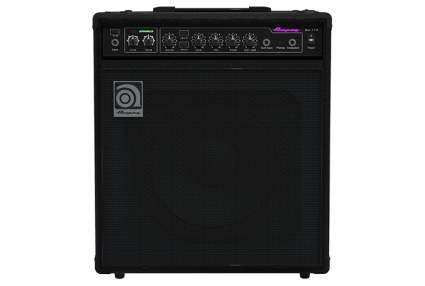
|
Amazon Customer Reviews
|
Price: $299.99 Shop at Amazon | Shop now Read our review |
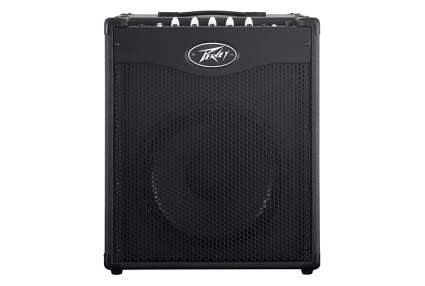
|
Amazon Customer Reviews
|
Price: $299.99 Shop at Amazon | Shop now Read our review |
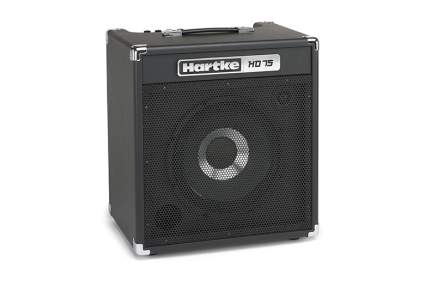
|
Amazon Customer Reviews
|
Price: $323.39 Shop at Amazon | Shop now Read our review |
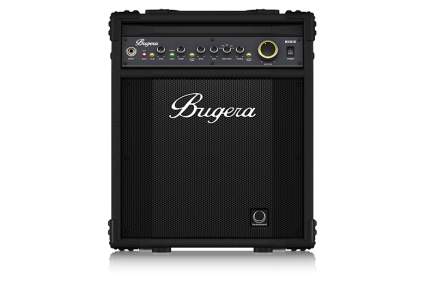
|
Amazon Customer Reviews
|
Price: $379.00 Shop at Amazon | Shop now Read our review |
-
1. Fender Rumble 100 v3 Bass Combo Amplifier
Pros:- Built-in foot-switchable overdrive circuit
- Effects loop and XLR output
- 100 watts
- Weighs only 22 pounds
Cons:- Some quality control issues
- Made in Indonesia — could be a turn off for some
- Good projection comes at the cost of some dynamics
- Tone may be nothing to write home about
Much like the counterparts aimed at the guitar crowd, Rumbles are among the most popular bass amps. Just sneaking in under our price cap, the 100 watt version is probably most analogous to the Fender Hot Rod Deluxe in that it’s just enough for gigs and provides a clean palette for your sound.
Controls include three voicing switches (Contour, Bright, and Vintage), a four-band EQ, Master volume, Drive and Level for the footswitch activated Overdrive circuit, and Gain. The Gain knob controls the input level from your bass and affects the compression on the Vintage voice and interacts with the Drive knob when Overdrive is engaged. In the event that 100 watts won’t help you cut through, this features an XLR out with ground lift so you can run directly to the front of house. There’s also an effects loop for the modern bassist with a pedalboard that rivals the guitarist. The speaker in this one is a 12 inch Eminence Special Design.
If you need more power, you can buy this in 200 and 500 watt versions, but those exceed our price cap. The 15, 25, and 40 are all considerably cheaper, but are even less likely to do the job in a live setting. One thing to note is that all of the Rumbles include Fender’s Delta-Comp limiter, which means playing louder or harder results in more compression to help prevent mudding out.
Find more Fender Rumble 100 v3 Bass Combo Amplifier information and reviews here.
-
2. Orange Crush Bass 50 Bass Guitar Amp Combo
Pros:- Active EQ with parametric mid control
- Bi-amp style with Blend knob
- Built-in tuner
- 12 inch speaker
Cons:- 50 watts may not be enough
- No XLR out
- Strong odor when first unpacked
- Made in China — could be a turn off for some
I have plenty of nice things to say about the Crush series from Orange, and talked about my 35RT in our small combo guitar amps post. If you watch this Andertons video on the bass versions, Captain Lee talks about that certain quality that good all-analogue solid state amps have. They’re not in tube territory, but for your practice needs, these can deliver surprisingly solid tones.
This breaks even between the Peavey and the Fender as there’s no XLR out, but there is an effects loop and a footswitch in for the bi-amp gain circuit. The other controls are Volume, a three-band EQ, Freq, Blend, and Gain. The EQ is active and the treble can be boosted or cut 20 dB, while the Middle and Bass has a range of 15 dB. The Freq knob moves the center frequency of the Middle control. Blend works with the Gain control and controls the ratio of clean to distorted tones and upper harmonics. This comes before the EQ section at the preamp. The Input has a Pad switch for matching to passive or active pickups. To top it off, there’s a built-in tuner, which I have found very handy on my Orange.
Find more Orange Crush Bass 50 Bass Guitar Amp Combo information and reviews here.
-
3. Ampeg BA-112 v2 Combo Bass Amplifier
Pros:- Scrambler overdrive circuit
- Wedge-shaped cabinet design
- -15 dB input pad
- All-steel amp chassis
Cons:- Consistent complaints of fan noise
- Scrambler circuit doesn’t quite live up to the SVT billing
- Made in China — could be a turn off for some
Ampeg is, of course, a monster of the bass amp game. Everyone knows the SVT and the B-15 Portaflex for their many contributions to music. The company continues to offer innovative solutions and great tones for bassists of every kind.
This offering is pretty squarely aimed at practice settings. At 75 watts, it may be able to gig, but just. With a dedicated AUX Level knob for the AUX input, playing along with recorded tracks is front and center. Other controls include an input pad, Volume, Bass, Mid, and Treble. The overdrive circuit is called Scrambler and features a Drive and Blend knob. Two switches enhance the EQ, with Ultra Hi boosting the 8 kHz frequency by five dB, and Ultra Lo boosting 40 Hz by one dB combined with a 10 dB cut at 500 Hz. The cabinet itself is angled much like a monitor for better projection.
There are two notable drawbacks to this amp. First, the company compares the Scrambler circuit to the venerable SVT drive. This is a fairly generous comparison and should be taken with a grain of salt. Second, there’s a prominent noise from the internal fan. This probably won’t make much of a difference unless you’re recording, but it’s something to be aware of.
If you know you’ll only use it for practice, you could go for the BA-110 40 watt version, which is only $179.99.
Find more Ampeg BA-112 v2 Combo Bass Amplifier information and reviews here.
-
4. Peavey Max 100 Bass Combo Amplifier
Pros:- Tilt-back cabinet
- On-board tuner
- Hybrid tube boost circuit
- Only weighs 35 pounds
Cons:- Ten-inch speaker may not move enough air
- Some complain that the tone is a bit stiff
- No XLR out
- Made in China — could be a turn off for some
As someone who has owned multiple Peavey amps in his life, I can tell you one thing is consistent about them: they’re very loud. For their wattage, for their size, for the price; however you put it, Peaveys can project. I can also attest to their reliability as the two I owned were consistently punished and never wavered.
This 100 watt amp is $30 less than the Fender above, largely with the trade-off of the I/O options. Controls include Gain with Peavey TransTube boost circuit, three-band EQ with Mid-Shift switch, and Volume with something the company calls “Psycho-Acoustics Technology”. This is a low end enhancement that does’t overdrive the speaker by boosting harmonics and filtering out the majority of the signal below a certain threshold. (You can read more about how that works here.) There’s also a built-in tuner that mutes the amp when on, as well as inputs for Passive and Active pickups.
The Max Series includes entries at 10, 20, 200, and 300 watts, as well. Only the models at 100 watts and above come with the tilt-back cabinets, though, which could come in handy on some stages.
Find more Peavey Max 110 Bass Combo Amplifier information and reviews here.
-
5. Hartke HD75 Bass Combo
Pros:- Aluminum-paper 12 inch cone and one-inch tweeter
- Seven-band EQ
- Effects loop
- Parametric bass, mid, and treble controls
Cons:- No XLR output (HD150 has one, however)
- 48.2 pounds among the heavier in this category
- Chassis may require tightening to avoid rattling on some units
- Aluminum in the cone may contribute to a punchier, more mid-range sound
Hartke is another well-recognized name for bass amps. This 75-watt offering utilizes an aluminum and paper 12 inch cone to provide the expected warmth along with enough punch to cut through a mix. It might not be a sound to everyone’s liking, but the controls on this unit will more than make up for that.
In addition to Volume and parametric Bass, Mid, and Treble knobs, there’s a seven-band EQ. Each of the bands can be boosted or cut up to 12 dB for very precise tone shaping. You can dial back on some of the midrange that this amp produces while boosting the lows. Otherwise, there’s an AUX in, effects loop, and headphone jack. The input is capable of handling high and low input sources, and there’s a built-in limiter.
There are 15, 25, and 50 watt versions, while the 150 watt comes in at $379.99 and adds an XLR out.
Find more Hartke HD75 Bass Combo information and reviews here.
-
6. Bugera Ultrabass MXD12
Pros:- XLR out, tuner out, and effects loop
- Class D power (claimed 1,000 watts)
- Wedge-shaped cabinet
- MOSFET preamp and built-in compressor
Cons:- Almost certainly nowhere near 1,000 watts
- Pad may be necessary even with passive pickups
- Legacy Behringer product repackaged
- Made in China — could be a turn off for some
It’s possible that you might recognize this amp despite its new livery. As part of the Behringer realignment that sent their pedals to TC Electronic in the form of their new big-box, ultra cheap pedals, Bugera inherited some things from the amp line. That includes this Ultrabass with a Turbosound 12 inch speaker. There are some nifty features in this amp, which uses class D power like the Fender above. Bugera advertise that this is a 1,000 watt amp, but there’s just no way; all that power into one speaker would not sound great, so the reality is probably more like 300. Which is still significant for the money.
Controls include an input pad, Gain, switchable Comp, three-band EQ with five-way Mid Freq knob, switches for Ultra High and Ultra Low EQ, and a Master volume. There’s an XLR out, effects loop, tuner out, AUX In, and Footswitch in to control the must or loop. This, too, is a tilt-back cabinet for better projection.
If you can get over the spurious power claims, there are a lot of useful features in this amp. And who knows, maybe it really is that loud?
Find more Bugera Ultrabass MXD12 information and reviews here.
See also: